-
Essay #35 – Back in the USA 🇺🇸 – May 27, 2023
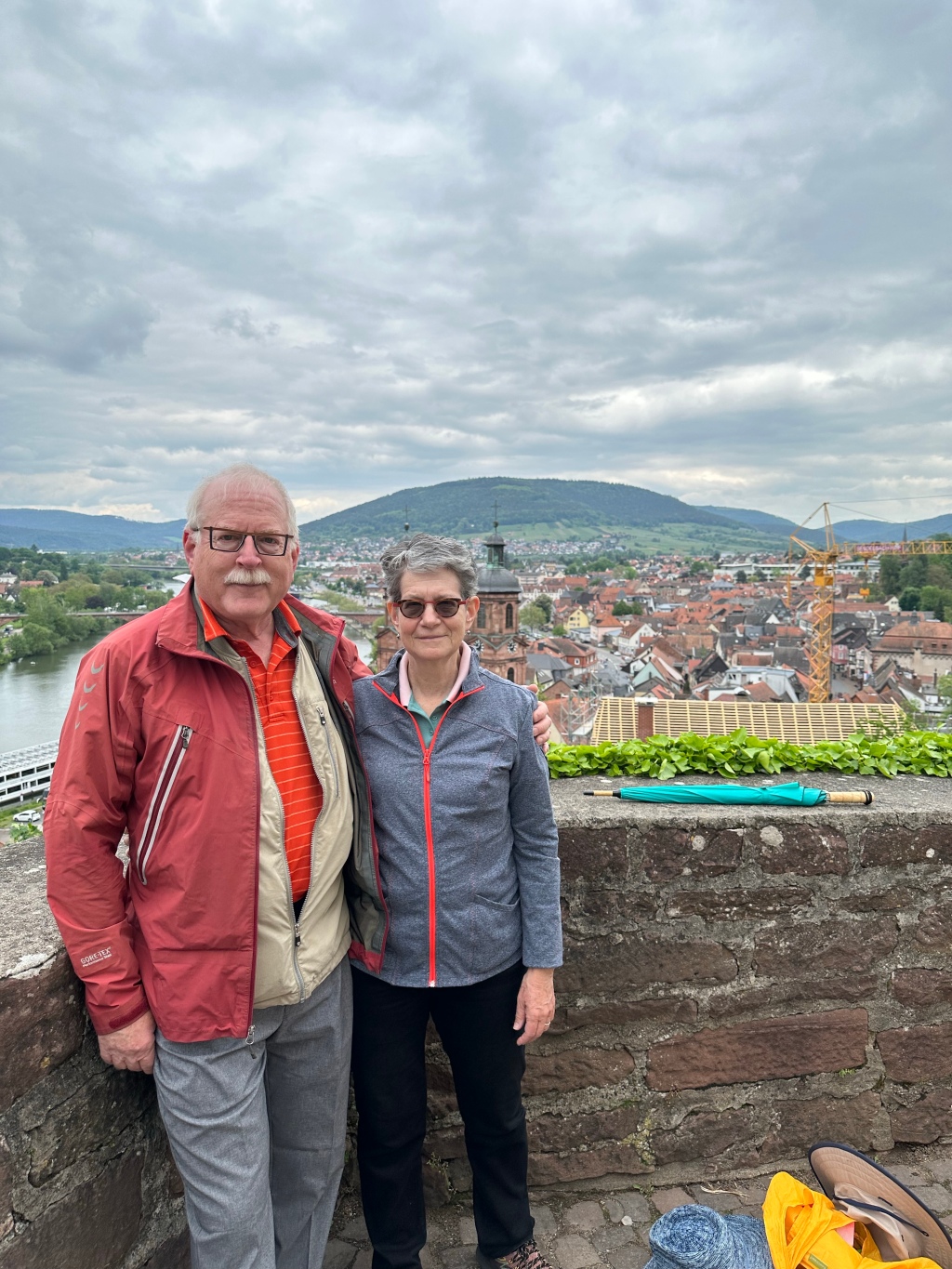
On Passover, we read that our forebears were wandering Arameans (Deuteronomy 26). Though interpretations vary, at its most basic level, it means that our people (starting with Abraham) wandered from Aram (northern Israel/Syria). (Click on any word in blue for link to article or other source)

From my most recent visit to the Negev Desert, Israel My family is part of a people centered on a common origin, culture and history that today is called Judaism.
We are links in this long chain stretching back to Abraham. Freund family lore is that during the Spanish Inquisition, we left for Germany and settled there. We have proof that family lived in Germany in the late 1600’s. Beginning in the late 1800s, and especially during the 1930s, like Abraham most of our family left comfortable and familiar lives in their homeland (Aram for Abraham, Germany for us). They and their children scattered around the globe.
Three hundred years in one place makes for deep roots.
I undertook my genealogy adventure to understand and honor my ancestors, to get to know today’s Germans, and to work toward a better future.
I am lucky to have been born in the USA. America has been good to us—so far.

Most of my life has been during a Golden Age for American Jews. Alas, Jew-hatred has become a concern in America.
Every country has people who hate Jews. After WWII, Jews have been widely accepted in the United States. But lately, a disturbing number of leading American politicians—mostly from one party—have spread anti-Jewish lies, misleading ordinary Americans. Lies breed more lies: consider the Florida mother who has been posting hateful propaganda from the 1903 Czarist forgery, The Protocols of the Elders of Zion.

Maybe I was naive to think that such things are unAmerican.
Many of today’s Germans are focused on remembering and learning from the past. At memorials for my relatives, Nuremberg and Munich officials had tears in their eyes, genuine sorrow for the genocide their ancestors perpetrated.
The students to whom my father (via Zoom) and I spoke were attentive. One could hear a pin drop in the room. The teachers told me that most of the 200+ students were moved. Articles were written in each town about my visit and what it meant to the students.

Article entitled “Paula’s Lebkuchen or the unbelievable story of the Freund family” Local residents in many towns work in the archives to put Jewish history online. The documents help create a picture of our families’ lives.

I’m holding a list of members of the Alsfeld synagogue of which my grandfather Adolf was president in the early 1930s. The synagogue was destroyed in 1938 by the non-Jewish people of Alsfeld. My friend Sascha Reif, an historian and computer engineer who did research on my family’s Alsfeld roots, looks on. Yesterday in Nürnberg, the 100,000th European “Stumbling Stone” commemorating murdered Jews was laid. The stone for my Great-Aunt Karoline, the first stone of the day, was the 99,998th. As you saw yesterday, “Stumbling Stone” originator Gunter Demnig himself came for the installation.

The final touches 
A popular German TV station filmed our ceremony. In the piece as edited for broadcast is my singing in the background while my cousin Carol (who lives in The Netherlands) talks about her grandmother Karoline, for whom she is named. The short video will show you how a Stumbling Stone is installed. Here are links to my singing the video and the article.
My 17 days in Germany were emotionally and intellectually difficult. And I’m glad I went. The months I spent preparing, and the trip itself, helped me reconcile the toll Nazi Germany took on the Steinbergers and the Freunds, with the many modern Germans who preserve the memory of my family and my people in my ancestral homeland.
This morning I made my getaway.

Landed! On the JFK AirTrain in New York City. I missed the sights, smells and sounds of home. Even the New York City subway. Especially the subway; it takes me from one end to the other of this vast city of as many as 800 languages for only $1.35. After weeks of German language immersion, what a pleasure to hear English—and everything else.
Thanks to all of you who joined me on this trip by reading my essays, writing to me, “liking” or commenting on a post. I couldn’t have written an illustrated essay each night without your engagement and encouragement.
Thanks to my German friends who helped me find my roots and who gave me the opportunity to speak with the students who are the world’s future. Thanks to my tutor, Daniela, who taught me to speak German well enough to engage with those students.

I could not have done this trip without Jeffrey’s love and support. He drove me 1200 km (720 miles) on narrow streets and wild Autobahns, took photos, edited my essays, and was bombarded with (to him) unintelligible German. Take these lessons from what happened to my German family:
People should be allowed to be themselves. Tolerance of non-conformists isn’t enough. We must accept people for who they are.
Sometimes one person can make a difference, can save a life or alleviate someone’s pain.
Peter Schneider wrote in The New York Times in 2000, “In the end, it isn’t the justly admired, death-defying resistance fighters who decide whether a society will succumb to totalitarianism. The success of a dictatorship, like the success of the resistance to it, depends not on a few ‘great leaders’ but on the civic virtue of the average citizen.” I have come to know many Germans through my study of the German language and my work on Jewish history. In their quiet way, they display that vital civic virtue.
Step-by-step, they are making Germany better than they inherited it. We must do the same in the United States.
Now, it’s time to turn my attention to the present and to continue to build on the chain that has linked us back to Abraham of Aram—and to Abraham Lincoln.
To read prior essays, click HERE.
-
Essay #34 – Stolperstein/Stumbling Stone in Nürnberg – May 26, 2023
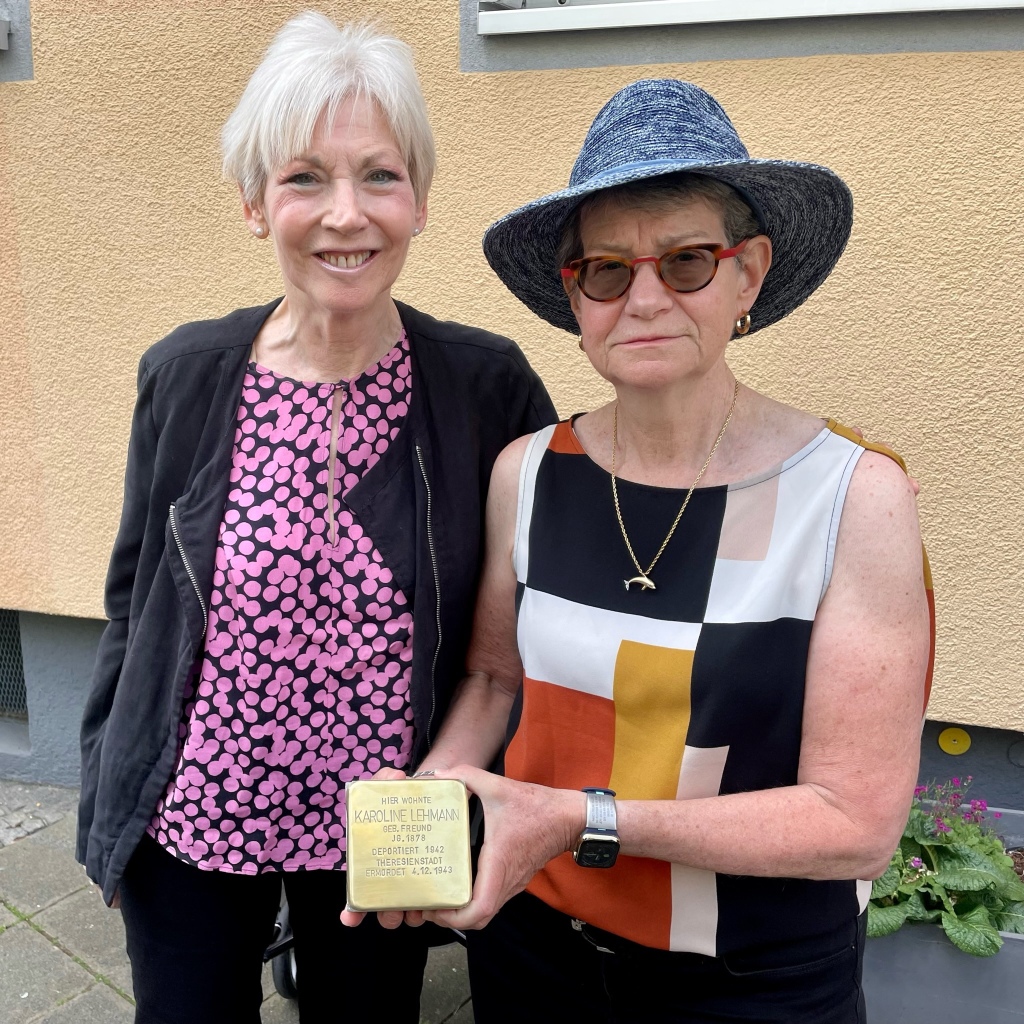
Karoline Lehmann born Freund was blinded by glaucoma in mid-life. America didn’t accept blind immigrants for fear that they would be a financial burden. The Nazis deported her to Theresienstadt, where she died of starvation and sickness. She had no grave and no funeral. Her family had no place to mourn my Great-Aunt Karoline, until today.

The City of Nürnberg honored Karoline today, outside the apartment building where she lived.

A block was marked for installation of the Stolperstein, or Stumbling Stone. Representing Nürnberg was Dr. Pascal Metzger, who spoke about the memorials for the Jews. Some neighbors attended. I brought 20 printed copies of a short memorial ceremony in German, Hebrew and English.

Dr. Metzger is to my right. 
Discussing Karoline’s life. 
Cousin Carol is named for her grandmother, Karoline. We held the stumbling stone before it was placed into the sidewalk by Gunter Demnig, who invented the Solperstein. 

Mr. Demnig preparing to lay the stone in front of Glockenhofstrasse 12. 
Sandy and me. Done. 
“Here lived KAROLINE LEHMANN • born Freund • in 1878 • Deported 1942 • Theresienstadt • Murdered 4 December 1943” 

Carol and I were interviewed by a local television station. After the installation of the stumbling stone, the family lunched with friends from Nürnberg, Miltenberg, and Amsterdam.

Reiner, Jeffrey, Sibylle, Ulrike, Toni, me, Sandy, Judy and Carol. It will take time to digest what I did on this trip: teaching students, visiting archives, connecting with friends, touring cemeteries, placing memorials in Munich and Nürnberg, writing essays. What was accomplished? What does it mean?
Tomorrow I fly home with Jeffrey to New York City.
I hope this trip was a step toward Tikkun Olam—repair of the world—by my family and my German friends and colleagues.
I’ll write next from Manhattan: Russell Shorto’s “Island at the Center of the World”.
To read prior essays, click HERE.
-
Essay #33 – Not Forgotten in Munich – May 25, 2023
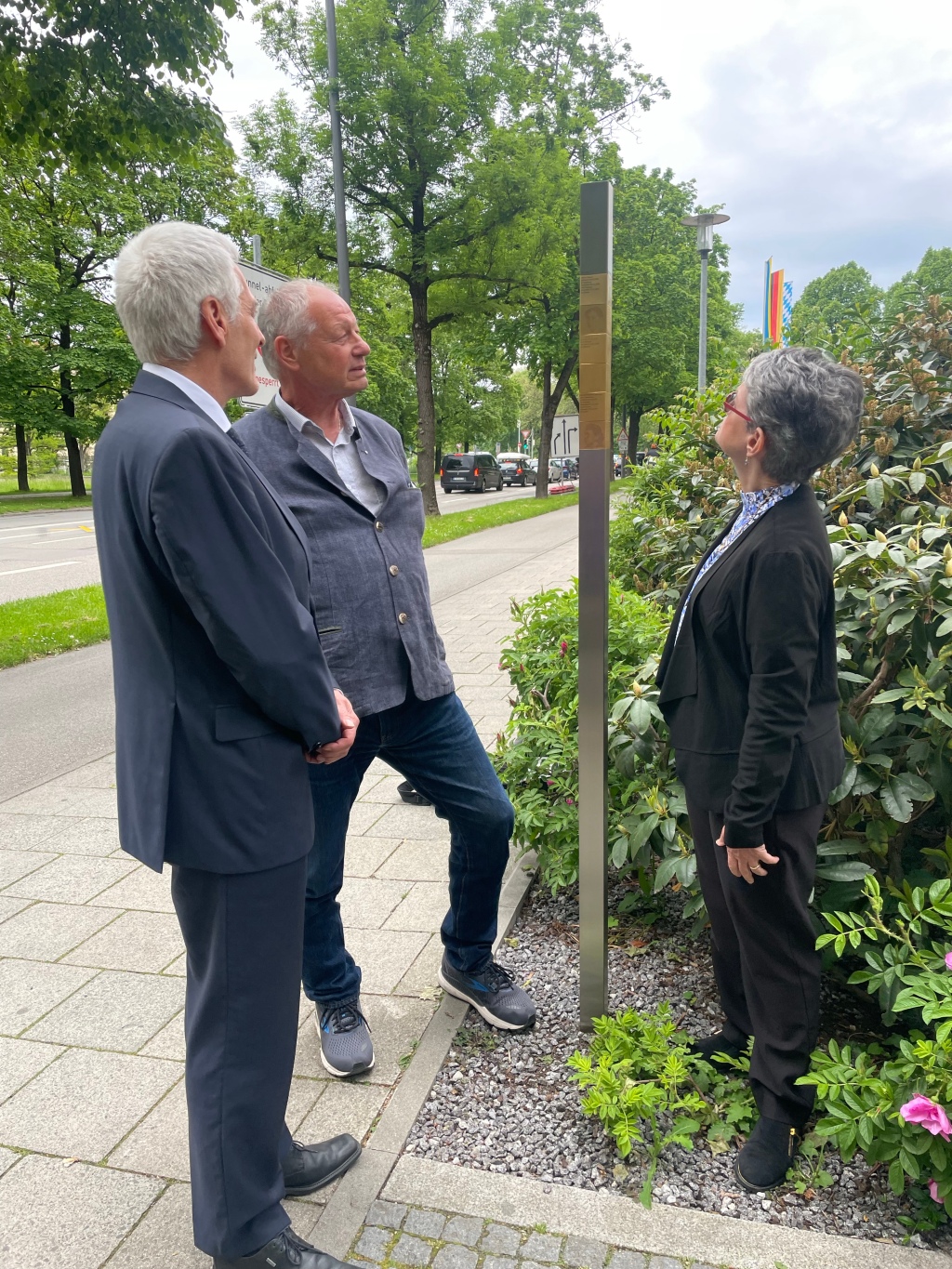
Jews murdered by the Nazis were denied the dignity of a funeral and a place for mourning and remembrance. Yesterday, the city of Munich made amends, erecting stainless steel monuments, promising to read the names aloud every year, and giving the family time and a place to mourn and say goodbye.
The head of the Central Archives of Munich (Dr. Daniel Baumann), a representative of the Lord Mayor of Munich (Dr. Evelyne Menges) and a representative from cultural department of the state capital (Barbara Hutzelmann) spoke about the horrors of the Nazi period and the murder of our family. With tears and in sorrow, they addressed the gathered family, friends and guests, acknowledging Germany’s responsibility although they, personally, are not responsible for what happened before they were born.

Dr. Daniel Baumann and me before the presentation. About 20 people attended this first of the day’s ceremonies. 
Dr. Evelyn Menges I gave a eulogy for seven lost family members. Jeffrey and Sandy read poems that I had chosen. I sang from Psalm 92, Tzadik Katamar, to the melody by Jewish German composer Louis Lewandowski (1821-1894). Then we all said Kaddish, the traditional Jewish mourning recitation that is a hymn, not a prayer; is in Aramaic, not in Hebrew; and does not mention God. All the speakers agreed that repair of the world (in Hebrew, tikkun olam) requires reconciling with the past.
We proceeded to four locations in Munich to install seven memorials for the Sänger family. Unlike “stumbling stone” memorials installed on sidewalks, Munich authorities decided that the names of persecuted Jews should not be stepped on but should be elevated to eye level.
The Munich memorials include images of the victim and birth and death information. Some memorials were installed on the sides of original buildings if the owner gave permission. If the victim’s residence had been demolished or the owner did not consent, a memorial column was erected on state-owned property. At each location, a police officer stood by, an official representative from the district gave a speech, and I gave a eulogy and thanked our sponsors.

Selma Sänger memorial on the side of a building at 2 Haimhauserstraße At 2 Haimhauserstraße, neighbors came out to pay tribute. The building’s owners drove two hours from Salzburg, Austria, to honor our family. A tenant welcomed us into her grand old apartment with its high ceilings and spacious rooms; it could have been the Sängers’ home. She showed us a desk, left in the apartment, that might have belonged to our family.
After speaking to the group outdoors, I broke down and sobbed uncontrollably. So much loss, violence, inhumanity, beyond logic. Murder on such a grand scale.

Selma Sänger and her husband Stephen went to Theresienstadt when Selma’s mother was deported, so she would not be alone. Selma was murdered in Auschwitz 7 months before WWII ended. 
Stephen Sänger was a decorated WWI veteran of the German Army. He also died in Auschwitz. Our closest Sänger relatives were remembered on one column. All were sent to Piaski, a ghetto hellhole. Disease or starvation likely took their lives. Even there, engineer Fritz Sänger worked to improve sanitation and to prevent the spread of typhus. He, his wife Irene, their 8 year old daughter Anneliese, and Fritz’s sister Berta, all died on dates unknown, most likely of starvation or disease.

From bottom to top: Berta, Fritz, Irene, and Anneliese. 
Cousin Carol spoke of her relief that our family, deprived of a final resting place, at last has a memorial in the city they once loved. 
Memorial for Alfred Sänger. At left is Tom, a district official. Alfred’s grandson-in-law, Manuel, who lives in Berlin, was glad to meet his American family. 
Alfred Sänger earned the Iron Cross in WWI, fighting for Germany. He was shot by German soldiers as he got off a train in Kovno, Lithuania, in the Ninth Fort Massacre. A local Munich newspaper picked up the story and published two articles in German ://www.wochenanzeiger-muenchen.de/sendling/jetzt-gibt-es-wieder-einen-platz-fuer-sie,152561.html and https://www.tz.de/muenchen/stadt/hallo-muenchen/muenchen-altstadt-gedenk-tafel-erinnerung-kultur-zeichen-leben-holocaust-nazi-verfolgung-92299311.html. Email me for English translations.
This morning, we returned to Nuremberg where tomorrow we will lay a “stumbling stone” memorial for my great aunt.
This afternoon, we decided to tour the ancient beer cellars carved into the sandstone under Nuremberg. No Nazi nightmares this afternoon!
So we thought.
At the cellars’ entrance, a guide explained that the underground rooms had been modified into bomb shelters for German Army officers during WWII.
Along the deep stairway was an American bomb of the sort that destroyed 90% of Nuremberg’s Old City.

My friend Judy didn’t know what to make of the bomb. I had a strong opinion. 
What goes around comes around. 
Karma Past the bomb shelters, tens of meters underground, I enjoyed learning about beer, geology, and the water table.

Being short—“in height only”, as my Nuremberg grandfather Hugo would say—has its advantages. These have been a trying few days. But horrors notwithstanding, the world turns, the beer brews, and life goes on.
A better life, if we work to make it so.
To read prior essays, click HERE.
-
Essay #32 – Memorial Plaques for 7 in Munich – May 24, 2023
In the company of supportive friends, my sister Sandy, my cousin Carol, newly discovered kin, and marvelous people from the Munich municipal government, today we placed seven memorial plaques in five locations around Munich.
My brain is fried, my emotions strung out, and I need time to process the day.
I will write more tomorrow.
To read prior essays, click HERE.


-
Essay #31 – Engineering in München- May 23, 2023
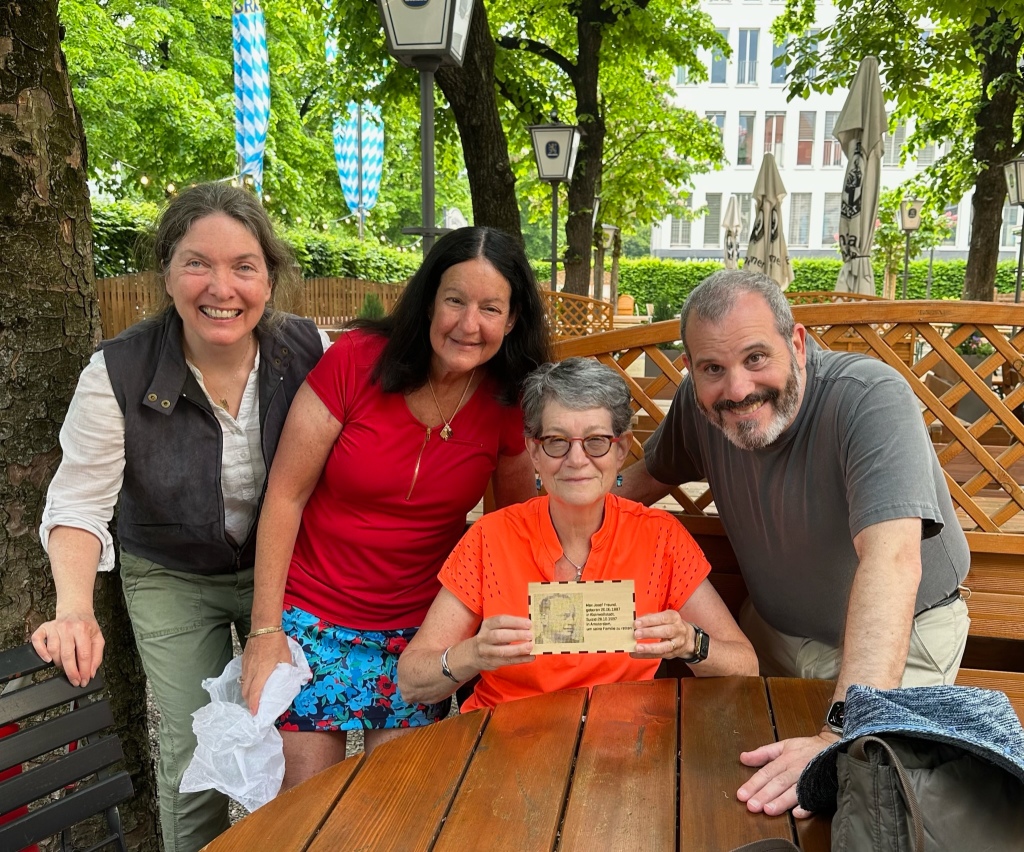
Engineering is the action of working artfully to bring something about. For the last year, I have worked on memorials for relatives murdered in the Shoah.
Today, disparate Freund family members gathered in München. We all grew up thinking we were the only Freunds in a small family. False!
I met these Freunds for the first time. Then I introduced them to the historians in München and Kleinwallstadt who connected the family tree and arranged for our remembrance ceremonies tomorrow.
Deb and I began the conversation when I saw online that her husband’s grandfather was born in the Freund family hometown of Kleinwallstadt. Her husband, Roger, arranged for nearly 30 of his family members to come to München.

Deb, Sandy, me and Roger. Roger gave me a handmade box memorializing my cousin Max Freund (Roger’s grandfather). Information on the family tree spread across the globe. Cousin Philip Freund emailed me from Israel and came with his family.

Philip and me 
Counterclockwise from left: Me, Philip, Laura, Belle-Anne, Jackie and Sandy At dinner, we spoke with Barbara (a historian) and Stefan (a volunteer) who helped create biographies of the murdered. Achim of Kleinwallstadt provided critical family information and joined us too.
I first phoned Barbara over a year ago. She answered my call on the street and was so enthralled that she stood outside without complaint although her hands were freezing. While in high school, Barbara was stunned to learn of the Holocaust. She learned that her grandparents had not been members of the Nazi party. Her empathy shows as she works with families like mine.

Barbara and me. 
Clockwise from left: Achim, me, Barbara, cousin Carol and her friend Judy, Jeffrey, Stefan and Sandy. Family memorials aren’t the only things that Freunds engineer. Some of Sandy’s and my forebears were sanitation engineers. I can prove it.
Archivist Katrin took us to her office at the Technical University of München. Before I arrived in Germany, Katrin and I conferred for hours as she patiently reviewed and translated documents related to the extended Freund family.

Me, Sandy, Katrin and Eva, at the Technical University. 
We’re holding Fritz Sänger’s 1919 engineering diploma. It was fitting that our day included some engineered building equipment, though I don’t know what this thing does!

Amid all this, Sandy and I took a break to visit München’s world-class Alte Pinakothek art museum.
There were self portraits.

Dürer 
Cézanne 
Rembrandt 
Brueghel’s Jonah and the Whale 
Van Gogh scene 
Klimt portrait I think of how the European culture that produced Dürer, Cézanne, Rembrandt, Brueghel, Van Gogh, and Klimt, also produced fascism.
How thin is the veneer of civilization.
To read prior essays, click HERE.
-
Essay #30 – Making Connections in München – May 22, 2023
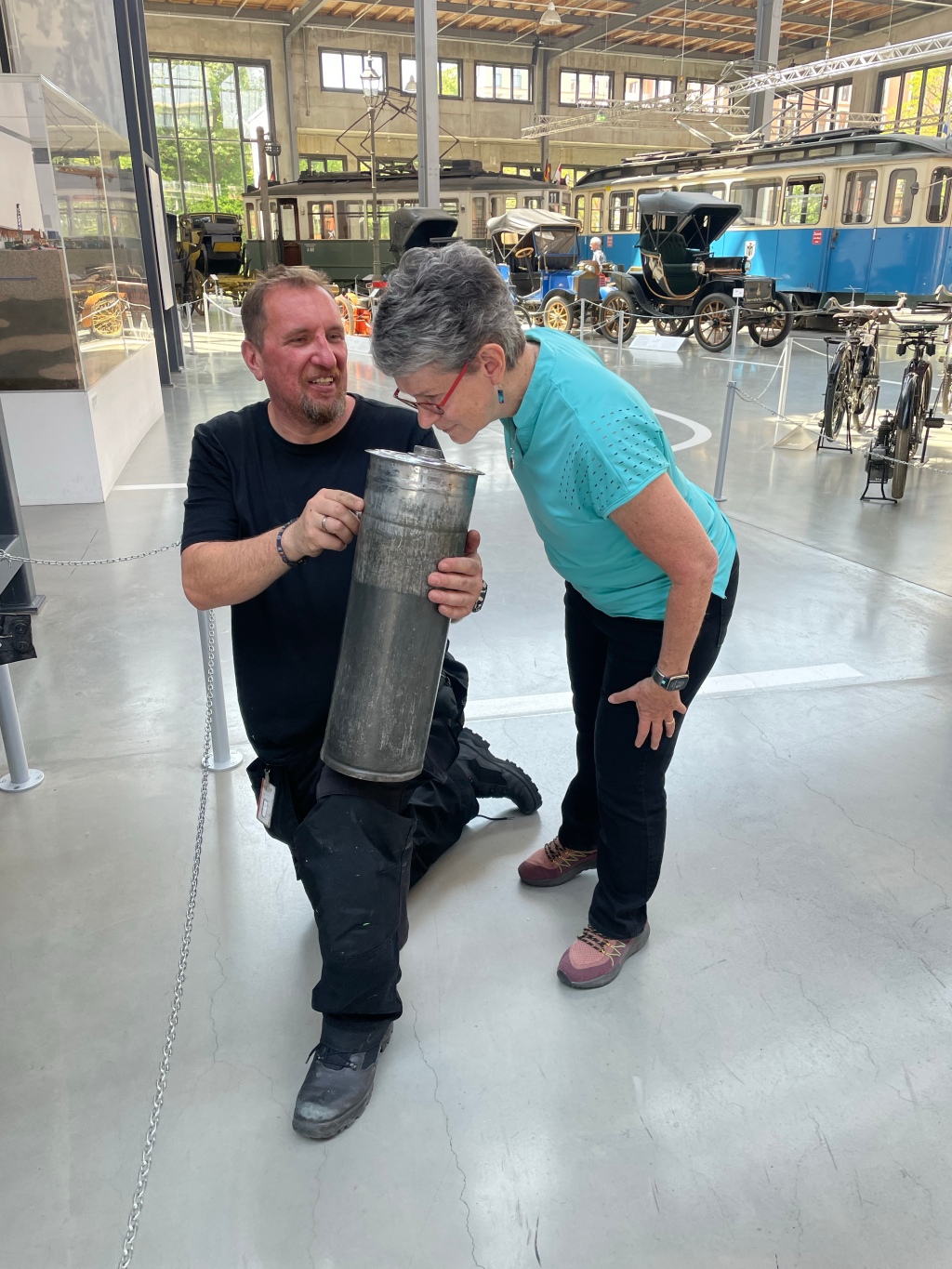
The Transit Museum in München is a special place for us.
Last July, we spotted an intercity tram identical to the one my father rode daily from Nürnberg to a Jewish school in nearby Fürth, after the German government expelled Jews from public school. Museum staffer Christian told us that where we were standing was off limits. I told Christian my father’s story. Christian ran to get a key and warmly ushered us onto the tram.
Christian and I stayed in touch.
Today he welcomed us back.

Christian and me today! 
The Nürnberg to Fürth tram and my dad, born the same year, carry their age well. This visit was even more wonderful. Dad joined us on FaceTime.

Me, our dad, and Sandy, sitting on the tram. My father talked about changing trams at Plärrer—and there it was on the tram map!

Showing dad the map 

Old Nürnberg trams at work 
Christian showed us a Daimler car like my grandfather’s. Can you guess what the removable cylinder is for? 
A sniff proved me right. It was a spare tank for gas! The museum has amazing vehicles. We found Jeffrey’s next bicycle.

The museum has a wonderful bike collection. 
Christian gave us a preview of a sobering new exhibit about traffic violence. He lightened the mood by revving up this 1906 replica of the 1814 English “Puffing Billy” steam locomotive. Christian’s friendship is a link in the chain that binds me to today’s Germany.
So is my friendship with Henrike. In 1932, my aunt Charlotte saved Henrike’s mother, Elizabeth, from drowning. (See essay #10 here.)

Henrike is an anthropologist who has studied some of America’s First Nations’ cultures. 
L to R: Ivica, Henrike, me, Jeffrey Connections like these enrich my life.
And they help repair the world.
Connections to history enrich and repair too. My years of research on family history led me to my friend Stefan—a volunteer who studies local Jewish history—and to Edel, a journalist who interviewed me today for the City of München’s Remembrance Organization.

L to R: Stefan, Edel, me, Jeffrey My work and these connections, and Stefan’s tireless help, have led to the placement in München later this week of memorials to members of my family murdered by their neighbors and their government in the early 1940s.
Not remembrance itself, but the lessons it teaches, help repair the world.
To round out the day, our cousin Carol arrived from Amsterdam and we connected over dinner at an Italian restaurant. The Italians are the best chefs in Germany.

L to R: Carol, Stefan, me, Carol’s friend Judy, Sandy, Jeffrey Carol brought postcards and a letter written by her grandmother, my great-aunt Karoline, more than eighty years ago.

Postmarked München, January 3, 1940 I’ll say more about Karoline soon.
To read prior essays, click HERE.
-
Essay #29 – Justice in Nürnberg – May 21, 2023
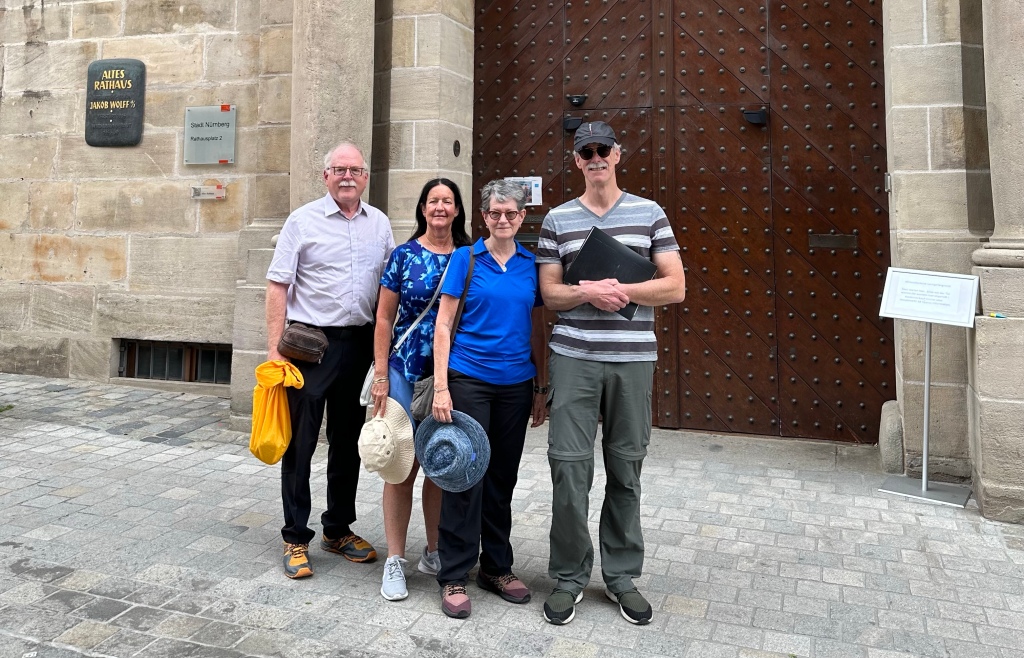
The first trial of leading Nazis was held in Nürnberg in 1945-46.
Nürnberg was chosen for practical reasons. It had a jail next to the large Palace of Justice courthouse. Both facilities had escaped serious damage from Allied bombs.
It was incidental, but fitting, that history’s first criminal trials of leaders of a defeated nation be here, where the Nazi party was powerful even before Hitler became chancellor, where murderous racism was the norm.
With “Kevin of Nuremberg Tours in English” as our smart and knowledgeable GUIDE (click to see his site), we learned details of the trial and sat in the courtroom. Then Kevin showed us Jewish sites around town.

L to R: Jeffrey, Sandy, me and tour guide Kevin. On trial were 22 men, including Hitler’s number 2 (Hermann Göring) and Auschwitz commander Rudolf Höss. Most were convicted and hanged (Höss in Auschwitz by the Poles); several served jail sentences; a few were acquitted. To avoid creating a Nazi shrine, the executed convicts’ ashes were dumped in a river.

Courtroom 600, where the Nazis were tried. 
Hermann Göring at trial. Göring committed suicide hours before he was to be hanged. 
Some of the defendants, Göring at left. The lead prosecutor, Henry Jackson, an associate justice of the U.S. Supreme Court, opened the trial on November 21, 1945, with these famous remarks:

“May it please Your Honors: The privilege of opening the first trial in history for crimes against the peace of the world imposes a grave responsibility. The wrongs which we seek to condemn and punish have been so calculated, so malignant, and so devastating, that civilization cannot tolerate their being ignored, because it cannot survive their being repeated. That four great nations, flushed with victory and stung with injury, stay the hand of vengeance and voluntarily submit their captive enemies to the judgment of the law, is one of the most significant tributes that Power has ever paid to Reason.”
The South German Newspaper reported the verdicts.

12 death sentences. 7 prison sentences. 3 acquittals. More trials were conducted later. Thus began the rebuilding of Germany as a strong and prosperous democracy.

Nürnberg’s vanished Jewish German community played a prominent role in the city’s pre-Nazi life.
For example, musician Billy Joel’s Nürnberg grandfather owned Germany’s second largest mail order business, Joel Macht Fabrik. After the Nazis took power, the Joel family escaped to Switzerland, then Cuba, then the USA. Billy was born in New York. Once again, Germany’s loss was America’s gain.

After the 2017 Charlottesville (Virginia) Nazi march when America’s then-president claimed that there were “good people on both sides”, Billy Joel wore a yellow star on stage at Madison Square Garden in protest. There is a memorial near the former site of Nürnberg’s reformed synagogue, which my grandfather attended.

The domed synagogue was destroyed in August 1938 on the orders of Nürnberg’s chief Nazi. 
The building. The people. Gone. 
Only a memorial remains. It’s sad when a people and a culture vanish from a place. To cheer up, we devoured some meatless Bavarian specialties.

Then we wandered a bit.

To read prior essays, click HERE.
-
Essay #28 – Emperors for a Day in Nürnberg – May 20, 2023
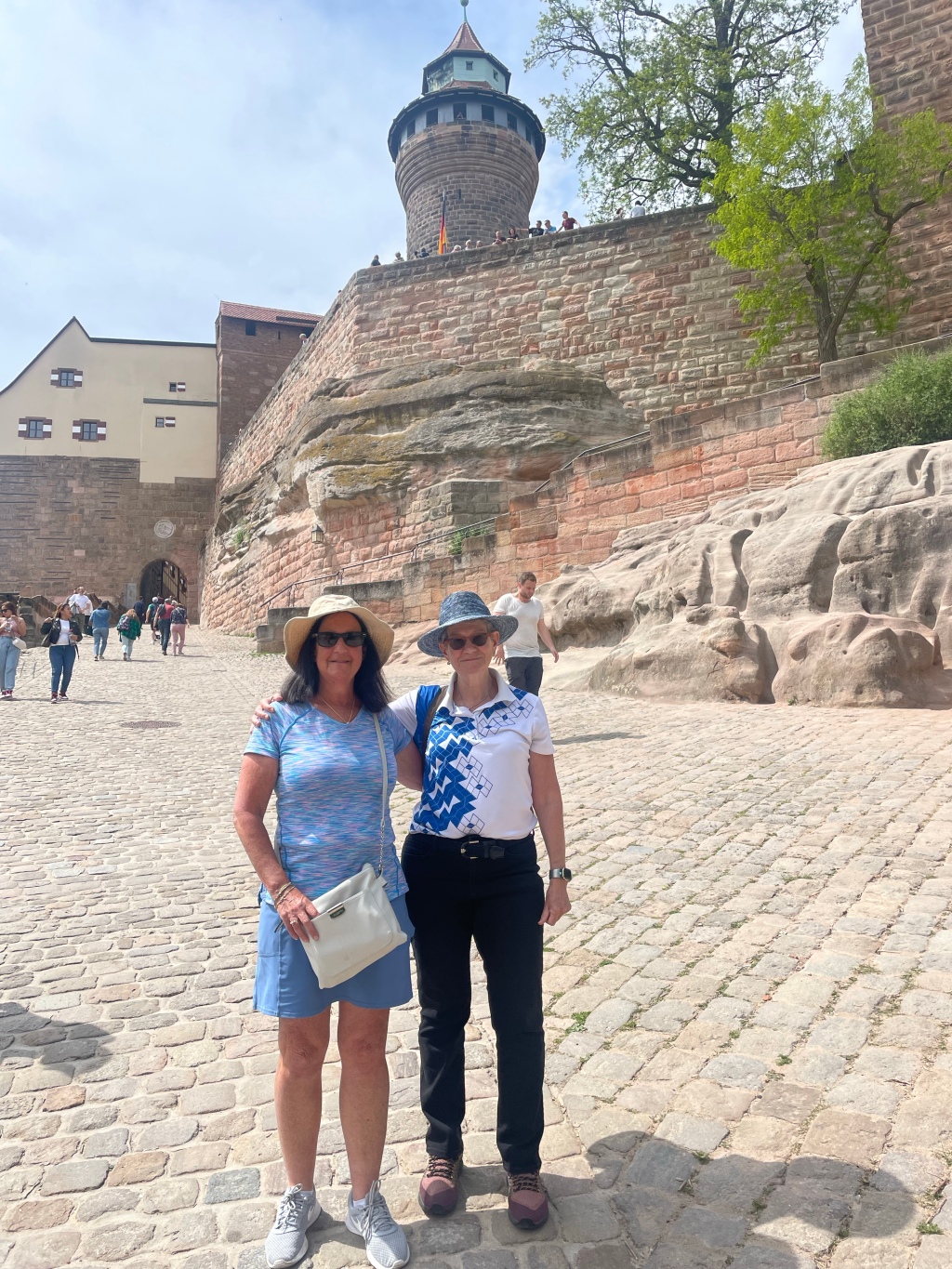
Nürnberg’s castle was a fortified site over a thousand years ago. Romans lived in town long before. Today, my sister Sandy arrived and we were imperial guests of the castle together with Jeffrey.
With Sandy came American sunshine and warmth!

Fresh from plane and train with little sleep, Sandy didn’t miss a step. I stood a few inches uphill to match her height. 
Charles IV reigned from 1346-1378. The original of this replica statue comes from Prague’s Charles Bridge, built in 1357. The eagle—single- and double-headed, depending on the era—has been a symbol of the Holy Roman Empire and of Germany for centuries.

This painting is outside the castle chapel, built in the 1200s. 
This is on a castle ceiling. It was removed for safe keeping during WWII. 
Modern Germans do not believe that two heads are better than one. The views from the castle tower are spectacular.



Festive red balloons. 
Nürnberg’s old town was almost obliterated by British and American bombing. What you see was rebuilt in the 1950s. 
From the 1920s until May 1945, Nürnberg was a center for Nazism. 
U.S. Army Air Force B-17 over Nürnberg, February 1945. Nürnberg reaped what it sowed. 
“Town Hall and Church of St. Sebaldus after the damage of World War II.” Modern Germany is proud of its colorful history and rich culture, and honest about its past of racism and murder.

This sign is prominently displayed in the castle, in German and English. We enjoyed a calm day and hope you are having a relaxing weekend.

Descending the tower. 
Descending from the castle. 
Ice cream To read prior essays, click HERE.
-
Essay #27 – The World according to Nürnberg – May 19, 2023
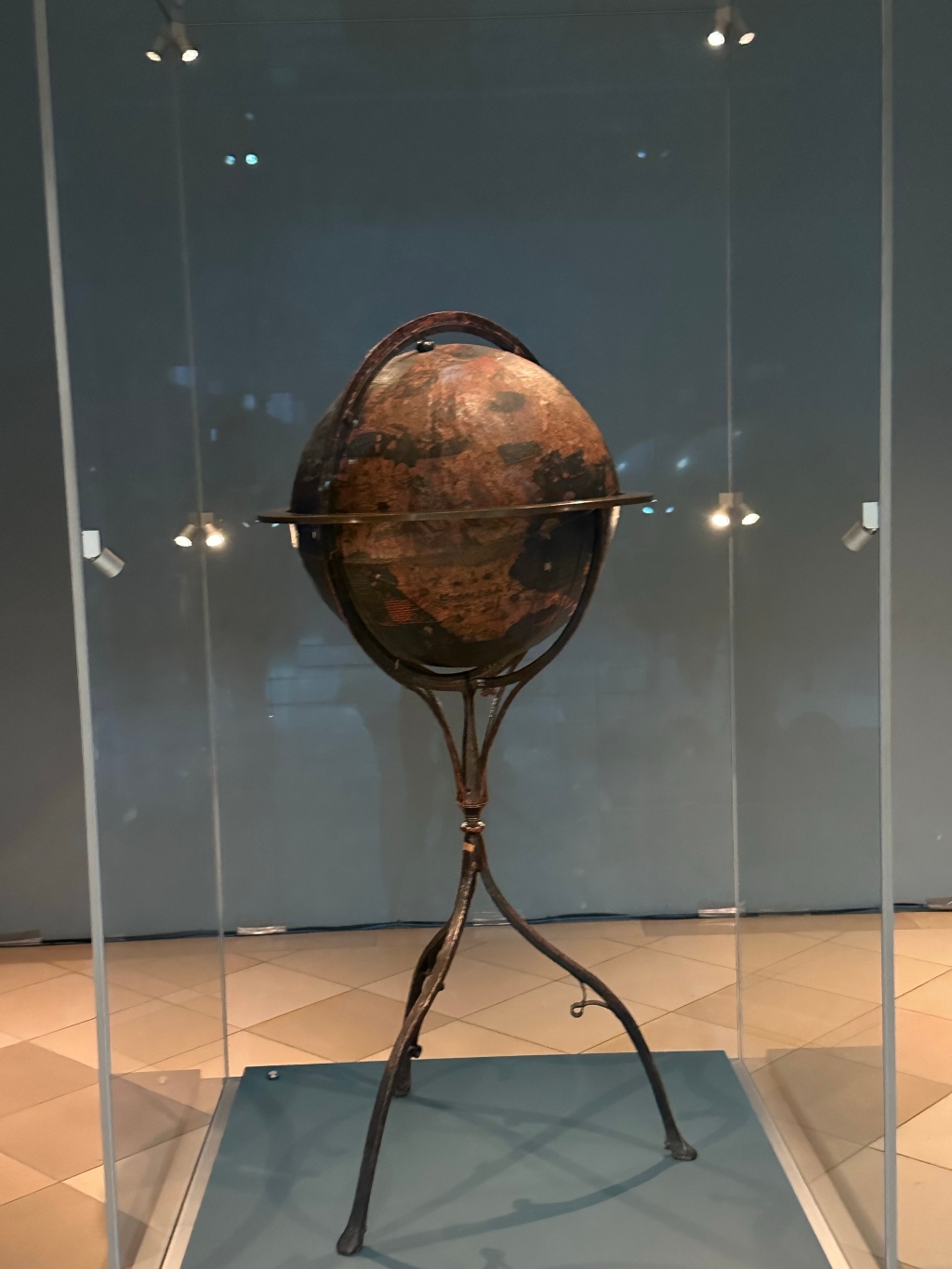
One of Germany’s National Museums is in Nürnberg. It houses some amazing stuff. After visiting cemeteries of my dead relatives and thinking and talking about the Nazi period, it was nice to think about earlier centuries.
Perspective is important. Cultures, countries, people, all come and go. Humans’ written and artistic record dates back millennia.
In 1492, when Columbus sailed the ocean blue, Nürnberg-born cartographer Martin Behaim created a globe based on writings by Pliny, Ptolemy and Marco Polo. Columbus was still at sea so America isn’t shown!

The Behaim globe is a World Heritage Object. South America showed up on a globe in 1520.

Where’s North America? The museum has Albrecht Dürer paintings, prehistoric tools, 15th century sandals, Roman coins, etc. Our era, our lifetimes, are just bits of lint on history’s fabric.

Albrecht Dürer’s painting of his mother wasn’t valued much. His painting of his father was widely admired. Why am I not surprised? 
This Rembrandt self portrait was identified as an original in 1998. 
A fragile gold headdress dating to the 11th century BCE was found in Germany in 1953 by a worker clearing tree stumps. 
These uncomfortable sandals conformed to 15th century municipal rulers governing the length of the pointed toes. During WWII, Nürnberg was destroyed by the British and American air forces. In the Church of our Lady, we saw photos of the rubble. It reminded me of photos of German synagogues after the November 1938 pogrom called Kristallnacht.
Poetic justice.

Bombed out church. Nürnberg was rebuilt to look old. It is charming today.

Good luck is said to come from turning the golden ring on this fountain. The fountain survived WWII bombing because it was encased in protective concrete.


In a week, we will return for the laying of a Stolperstein (“Stumbling Stone”) for my great aunt Karoline Lehmann born Freund. Herr Doktor Pascal Metzger arranged it. He and his lovely family joined us for dinner and conversation.

L toR: Jeffrey, me, Pascal, Elias and Nicole. Pascal’s wife, Nicole, an opera singer who teaches music theory, will bring her student choir to sing Hebrew memorial songs when I return next year to dedicate Stolpersteine for two more of my relatives.
To read prior essays, click HERE.
-
Essay #26 – Following In Their Hoofsteps – May 18, 2023
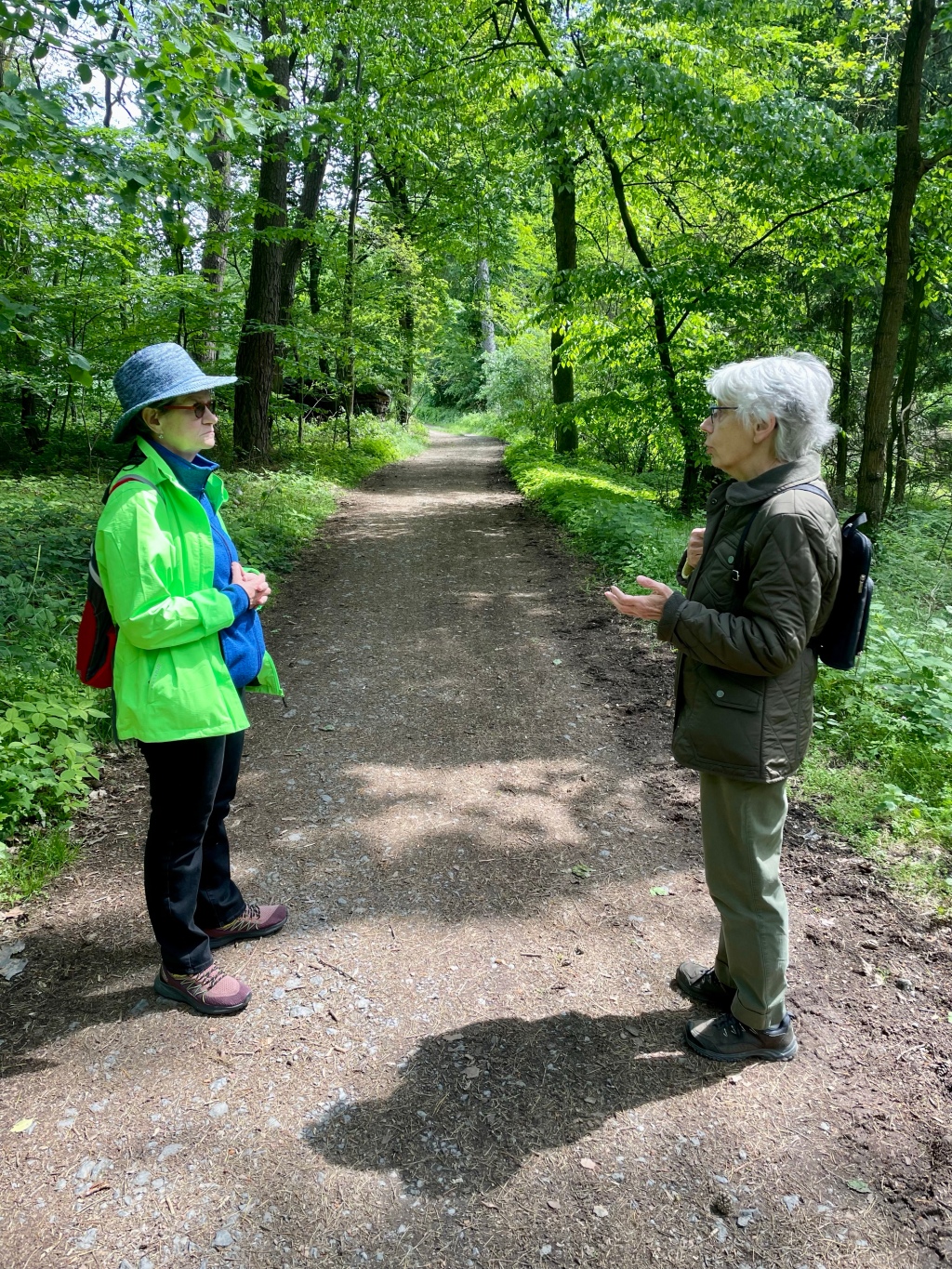
The sun shone on Aschaffenburg today.

Iris led us from the Schweinheim—“Pig-Home”—neighborhood, into the hills, to the old regional Jewish cemetery.

The arrow indicates the cemetery wall, seen across a cultivated field. Jews who lived in Aschaffenburg were buried in the city cemetery we visited yesterday. For the regional cemetery, the Jewish community chose this larger site, atop a steep hill well outside the city, so it would not be taken for development as the city grew.
This cemetery was established in 1735. The last burials here were in 1942, days before the final destruction of the local Jewish community. Time passes and these people are forgotten even before the sandstone erodes. It is sad but that’s the way of the world.


My family replaced my great-grandparents’ original headstone. Time and weather has made many of the stones here difficult or impossible to read. 
This stone, engraved after WWII, is in memory of seven of Aschaffenburg’s leading citizens, all Jewish Germans, who committed suicide after German authorities ordered their deportation to concentration camps in September 1942. Our family members who are buried here could not imagine what was to come. Iris showed us the graves of Caroline Freund and Karoline Freund, graves we have never seen.

Caroline Freund born Feldmann in 1825 
Karoline Wähler born Freund 1862 Iris told us that most Jews in this region were as poor as their neighbors. Until German society became more egalitarian in the late 1800s, many Jews could make a living only as peddlers or cattle dealers.
This path is part of the route Jews took to sell their wares and herd cattle from place to place.

The route was chosen to avoid towns where Jews knew they were not welcome. 
On a pole holding the official sign with details about the “Jewish Path” and the nearby cemetery is a sticker that echoes one of the themes of my Germany journey: “No Person Is Illegal”. The intensity of today’s walk where my ancestors and their cattle walked, was softened by the beauty of nature.




Now the path is used by walkers and cyclists, and by Christian pilgrims who pray at “stations of the cross”. We had a lovely trek through the trees with birds singing. I heard cuckoos call. They sounded just like the clocks!

After dining with Iris—she is a wonderful cook and the perfect host—I need a rest and time to reflect.

Freund Street I wish everyone peace.
To read prior essays, click HERE.
-
Subscribe
Subscribed
Already have a WordPress.com account? Log in now.